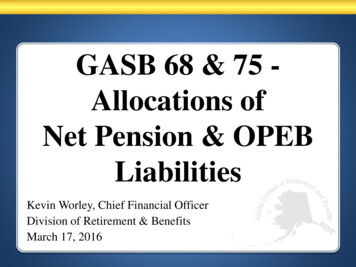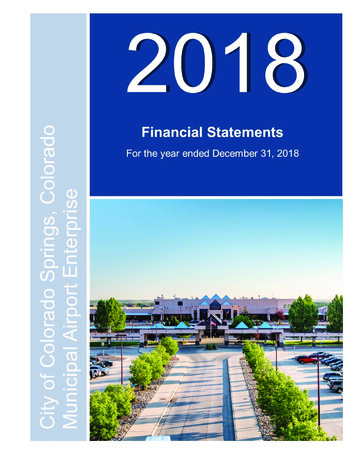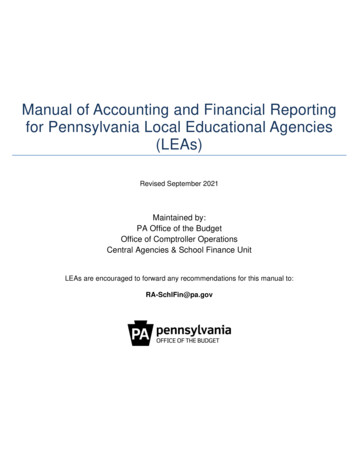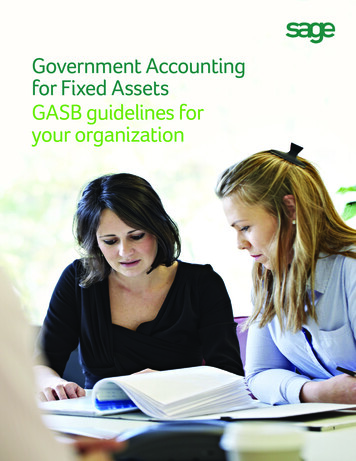
Transcription
GASB 75 & OPEB Frequently Asked QuestionsWhat is GASB?The Governmental Accounting Standards Board (GASB) is a national body that sets the standardsfor governmental accounting and financial reporting. Generally, these are the accounting standardsthat state and local governments as well as school districts use when preparing financial statementsin accordance with generally accepted accounting principles (GAAP). The Office of the New YorkState Comptroller (OSC) reviews these standards and provides guidance on how localgovernments and school districts should implement them.What is GASB Statement 75?The GASB issued Statement No. 75, Accounting and Financial Reporting for PostemploymentBenefits Other than Pensions (Statement 75), in June 2015. Statement 75 replaces the requirementsof GASB Statement No. 45 Accounting and Financial Reporting by Employers forPostemployment Benefits Other Than Pensions, (Statement 45) and issues new standards fordefined benefit OPEB and defined contribution OPEB provided to employees of state and localgovernments through OPEB plans. Its intent is to improve accounting and financial reporting byrequiring an OPEB liability to be reported on the face of the financial statements rather than in theaccompanying notes (as previously required by Statement 45).What are other post-employment benefits (OPEB)?Other post-employment benefits (OPEB) are employee benefits other than pensions that arereceived after employment ends.OPEB includes, but is not limited to, the following post-employment items: Medical benefits Dental benefits Vision benefits Prescription medicine benefits Hearing benefits Disability benefits, if not part of a pension plan Long-term health care benefits, if not part of a pension plan Life insurance, if provided separately from a pension plan Other health benefits, if not part of a pension planOPEB generally does not include: Pension income benefits Sabbaticals Vacation benefits Special termination benefits (unless the effect is an increase in benefits that are OPEBs) Consolidated Omnibus Budget Reconciliation Act (COBRA) benefits. COBRA providescertain former employees, retirees, spouses, former spouses and dependent children theright to temporary continuation of health coverage at group rates.Office of the New York State ComptrollerDivision of Local Government and School Accountability110 State Street, Albany, NY 122361
What information is required to be reported under Statement 75?Statement 75 requires local governments and school districts that prepare GAAP-compliantfinancial statements to report the total OPEB liability in the statement of net position in theirgovernment-wide financial statements. See our June 2018 accounting bulletin, Accounting andFinancial Reporting for Other Postemployment Benefits as Required by GASB Statement 75,for specific accounting and reporting requirements for GAAP-compliant financial statements andfor reporting requirements for the Annual Update Document (AUD)/ST-3. Implementation isrequired for local governments and school districts for fiscal years beginning after June 15, 2017.How does reporting Statement 75 on the AUD/ST-3 differ from Statement 45?Under Statement 45, the total unfunded actuarial accrued liabilities (UAAL) for past service costswere reported in the footnotes to the financial statements. Payments made for OPEB benefits wereexpensed when incurred. For AUD/ST-3 reporting, OPEB information was reported in the OPEBSupplemental Schedule and in the notes to the AUD.Under Statement 75, the total OPEB liability is required to be reported on the face of thegovernment-wide financial statements. For AUD/ST-3 reporting purposes, the total OPEB liabilitywill be reported on the Schedule of Non-Current Governmental Liabilities (W Schedule) for OPEBapplicable to governmental funds. Expenditures related to OPEB payments will continue to berecognized when incurred.If a local government has OPEB applicable to proprietary funds, then a portion of the total OPEBliability should be allocated between the W Schedule and the proprietary fund financial statements.Additionally, local governments must report OPEB expense and deferred inflows/outflows ofresources as applicable.OPEB information will continue to be reported in the notes to the AUD.See our July 2018 accounting bulletin, Accounting and Financial Reporting for OtherPostemployment Benefits as Required by GASB Statement 75.What governmental entities are required to comply with Statement 75?Statement 75 applies to all public entities (including state governments; county, city, town andvillage governments; and school districts) that follow GAAP in filing their annual financialstatements and offer OPEB. In New York State, it is estimated that about one-quarter of localgovernments and most school districts are required to comply.What types of OPEB plans do governments use?There are two basic forms of post-employment benefit plans. Defined benefit plans are those thatspecify the amount of benefits to be provided to employees after the end of their employment.Defined contribution plans stipulate only the amounts to be contributed by an employer to a planmember’s account for each year of active employment; such plans do not specify the amount ofOffice of the New York State ComptrollerDivision of Local Government and School Accountability110 State Street, Albany, NY 122362
benefits employees will receive after the end of their employment. The majority of localgovernments and school districts in NYS have single-employer defined benefit OPEB plans andas a result, our Statement 75 Accounting Bulletin guidance is focused on single-employer definedbenefit OPEB plans.How should governments participating in defined benefit plans account for OPEB?In general, governments should account for and report the annual cost of OPEB and the outstandingobligations and commitments related to OPEB in the same manner as they currently do forpensions. These amounts should be produced by actuarial valuations performed in accordance withparameters established by GASB. The valuations should be conducted at least every two yearswith more frequent valuations or calculations encouraged. Generally, actuarial valuations shouldbe performed in conformity with Actuarial Standards of Practice unless otherwise specified by theGASB.Actuarial Valuation and ServicesWho should an employer contact to obtain an actuarial valuation?You should to hire an actuarial consulting firm with expertise in health benefits to perform thevaluation work. OSC does not endorse or recommend any specific actuarial firms and the localgovernment should take care to comply with its procurement policies and procedures for obtainingprofessional services, which, as a rule, should provide for a request for proposal (RFP) process.We suggest that you contact the American Academy of Actuaries, the American Society ofPension Professionals & Actuaries (ASPPA), or the Society of Actuaries to obtain a list of actuarialfirms.What resources are available to help local governments procure these services?The Government Finance Officers Association (GFOA) has a checklist for Procuring ActuarialServices that could be helpful to local governments in obtaining actuarial services.OSC also suggests that school districts contact their local Board of Cooperative EducationalServices (BOCES) to inquire about possible actuarial services. Counties should contact the NewYork State Association of Counties (NYSAC) to inquire about possible actuarial services.Will OSC perform Statement 75 actuarial valuations for employers?No, OSC does not perform actuarial valuations for employers. For information on computing thespecific valuations, please refer directly to Statement 75.Office of the New York State ComptrollerDivision of Local Government and School Accountability110 State Street, Albany, NY 122363
What information must an employer provide to the actuary for employees and retirees?Data elements needed by actuarial firms to begin an actuarial valuation generally include: Employee name or identification number Gender Date of birth Date of hire Employee salary Bargaining unit Retirement date Employment status: active or retired Spousal and dependent information Contribution to the cost of the premium Type of benefit plan: individual or family with specific information on each planThe New York State Health Insurance Program (NYSHIP) may be able to provide some dataelements listed above to local governments who are members of NYSHIP. For more information,contact the Public Employer Liaison Unit of the New York State Department of Civil Service at(518) 485-1771. In addition, some of this information may have already been gathered andsubmitted for purposes of Medicare Part D. Check with your personnel officer.Can OSC provide local governments with data on retirees and/or current employeesparticipating in ERS?OSC can assist local governments in providing some of the required data on retirees and currentemployees, but local governments are the best source of most information required on theiremployees and the health benefit plans provided to them.What surprises should we be aware of in dealing with an actuarial OPEB valuation?Actuarial studies often produce future liabilities which are higher than initially expected. Inaddition, estimates of OPEB liabilities can be more volatile than pension liabilities from oneactuarial study to the next. The volatility is due to changing demographics (people living longerand retiring earlier), changes in the level of benefits offered and increases in health care costs thatare difficult to predict.Funding OPEB LiabilitiesWhat does GASB say about funding OPEB liabilities?GASB does not require that the OPEB liability of a government be funded. However, GASB hasadvised that if an employer decides to fund its OPEB liabilities, in order to be considered fundedin accordance with GASB, the employer must transfer assets to a qualifying trust or equivalentarrangement in which OPEB assets are held in trust for the exclusive benefit of plan members andOffice of the New York State ComptrollerDivision of Local Government and School Accountability110 State Street, Albany, NY 122364
their beneficiaries in accordance with the terms of the OPEB plan. These OPEB plan assets mustbe legally protected from creditors of the employer.Is there any State statute that expressly authorizes a local government in New York to createa trust for OPEB purposes?No, and in the absence of such a statute, it is questionable whether local governments have therequisite authority for establishing an OPEB trust. A State statute providing express authority ishighly advisable as it would eliminate questions as to the underlying authority for the creation ofthe trust.Can a local government in New York set aside moneys in a reserve fund to help financeOPEB?General Municipal Law, Section 6-p, allows municipal corporations in New York to establish andmaintain an Employee Benefit Accrued Liability Reserve Fund to help finance the cost of certain“employee benefits”. The term “employee benefits” is defined in the statute to include the cashpayment of the monetary value of accrued but unliquidated time earned by employees that ispayable upon termination of service. Typically, moneys in this reserve are set aside to pay foraccumulated, unused leave time when an employee separates from service. Currently, moneyscannot be accumulated in this reserve to fund a local government’s OPEB liability. Moreover, sucha reserve fund would likely not comply with all GASB requirements for a qualifying trust orequivalent arrangement. There is no other reserve fund authorized by General Municipal Law orany other law for this purpose.Can local governments issue OPEB bonds?Currently, local governments in New York State do not have the statutory authority to issue bondsto fund their OPEB liability.Other IssuesWe have provided healthcare benefits to our retirees for decades, but we have expresslyreserved the right to alter or discontinue benefits. Do we have to book an OPEB liabilityunder Statement 75?Probably. While employers often stipulate that post-employment healthcare benefits are not vestedor that the employer has the right to amend or discontinue benefits unilaterally, the current planand the employer’s historical pattern of providing benefits up to the time of the valuation providethe most objective and reliable basis for projection of benefits for financial reporting purposes.Consult with your attorney on the specific situation in your municipality.Office of the New York State ComptrollerDivision of Local Government and School Accountability110 State Street, Albany, NY 122365
Can we make major changes in our benefit structure?This will vary from one local government to another, and will generally depend in part on themanner in which the benefit was provided (e.g., board resolution, collective bargainingagreement), as well as the specific terms of the benefit.Ideally, the collective bargaining agreements or board resolutions that provide for the benefit willclearly specify the terms and conditions of coverage for retirees and current employees upon theirretirement, including whether changes may be made. Plan documents and other records may behelpful in certain instances in determining the extent of the local government’s commitment tocontinue to provide benefits or a particular level of benefits.However, collective bargaining agreements can change over time, sometimes making it unclearwhich agreement applies to a current or future retiree or group of retirees. Collective bargainingand healthcare plan documents may also contain confusing or even conflicting provisions. In somecases, State statute, local laws and court cases can affect coverage.Thorough research of a particular local government’s collective bargaining and employee benefitsdocuments is highly recommended. Because there often are legal issues to be resolved, it isadvisable to consult with your attorney.What if I just do nothing with OPEB and the new GASB requirements?Doing nothing may be risky. Local governments that do not comply with Statement 75 will nolonger be following GAAP standards which may have negative financial implications: Accounting firms may view non-compliance as a negative factor in their audit opinions. Bond rating agencies may view non-compliance as a negative factor in credit ratingswhich could result in a rating downgrade.What do credit rating agencies say about the funding of the OPEB liability?Credit rating agencies have stated that they will consider OPEB funding status in their evaluationsof government financial condition. It is possible that bond ratings may suffer for thosegovernments with large and/or mounting liabilities and no plan to pay for these future costs. Thismay be particularly true as certain governments move forward with OPEB strategies while othersdo not. The extent to which a local government’s OPEB funded status affects its overall creditrating may depend on a number of factors, including the issuer’s current rating and acomprehensive review of the issuer’s finances.Office of the New York State ComptrollerDivision of Local Government and School Accountability110 State Street, Albany, NY 122366
Where can I get additional information concerning Statement 75 and OPEB? GASB Statement No. 75 - Accounting and Financial Reporting for Postemployment BenefitsOther Than Pensions GASB Implementation Guide No. 2017-3, Accounting and Financial Reporting forPostemployment Benefits Other Than Pensions (and Certain Issues Related to OPEB PlanReporting) OSC Accounting Bulletin: Accounting and Financial Reporting for OtherPostemployment Benefits as Required by GASB Statement 75 New York State Government Finance Officers Association: Checklist for ProcuringOPEB Actuarial ValuationOffice of the New York State ComptrollerDivision of Local Government and School Accountability110 State Street, Albany, NY 122367
Generally, these are the accounting standards that state and local governments as well as school districts use when preparing financial statements in accordance with generally accepted accounting principles (GAAP). The Office of the New York State Comptroller (OSC) reviews these standards and provides guidance on how local .










